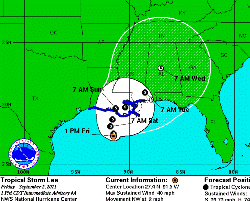US Gulf producers shut in nearly half of oil capacity amid Tropical Storm Lee
By Ben DuBose
Online Editor
 Oil and gas operators in the Gulf of Mexico are evacuating platforms and rigs due to Tropical Storm Lee, with nearly 48% of oil capacity and 33% of natural gas production shut in.
Oil and gas operators in the Gulf of Mexico are evacuating platforms and rigs due to Tropical Storm Lee, with nearly 48% of oil capacity and 33% of natural gas production shut in.
Lee intensified to become a tropical storm on Friday, according to the US National Hurricane Center (NHC), packing winds of 40 miles/hour. It is not expected to reach hurricane strength, but its winds could hit 65 miles/hour before making landfall in Louisiana on Sunday or Monday.
The Louisiana and Mississippi coastlines are filled with oil and gas infrastructure, and many offshore facilities are also in the region.
While it is too early to tell any potential impact to inland plants and refineries, the offshore firms have begun preparations in earnest.
BP, Shell, ExxonMobil, Murphy Oil, Marathon and Apache are among producers who have confirmed shutting in offshore production as well as evacuating personnel, according to news reports.
The US Bureau of Ocean Energy Management, Regulation, and Enforcement (BOEMRE) Hurricane Response Team is the agency in charge of monitoring offshore operator activity.
Based on data from operator reports submitted as of 11:30 a.m. Central time on Friday, personnel have been evacuated from 169 production platforms, equivalent to 27% of the 617 manned platforms in the Gulf of Mexico.
Production platforms are the structures located offshore from which oil and natural gas are produced. Unlike drilling rigs, which typically move from location to location, production facilities remain in the same location throughout a project’s duration.
Sixteen of the 62 rigs currently operating in the Gulf have been evacuated, representing 23% of overall activity. Rigs can include several types of self-contained offshore drilling facilities including jackup rigs, submersibles and semisubmersibles.
As part of the evacuation process, personnel activate the applicable shut-in procedure, which can frequently be accomplished from a remote location. This involves closing the sub-surface safety valves located below the surface of the ocean floor to prevent the release of oil or gas.
During the recent hurricane seasons, the shut-in valves functioned 100% of the time, efficiently shutting in production from wells on the Outer Continental Shelf and protecting the marine and coastal environments. Shutting-in oil and gas production is a standard procedure conducted by industry for safety and environmental reasons.
From operator reports, it is estimated that approximately 47.6% of the current oil production in the Gulf of Mexico has been shut-in, or about 666,321 bpd.
It is also estimated that approximately 33% of Gulf natural gas production has been shut-in, representing 1,743 MMCF/day.
The production percentages are calculated using information submitted by offshore operators in daily reports. Shut-in production information included in the reports is based on the amount of oil and gas the operator expected to produce that day.
On land, tropical storm warnings have been issued for the coastline from Sabine Pass, Texas, eastward to Pascagoula, Mississippi.
No inland chemical plant or refinery shutdowns had been reported as of midday Friday, but producers said they were closely monitoring the situation and could have further updates over the weekend.






Comments